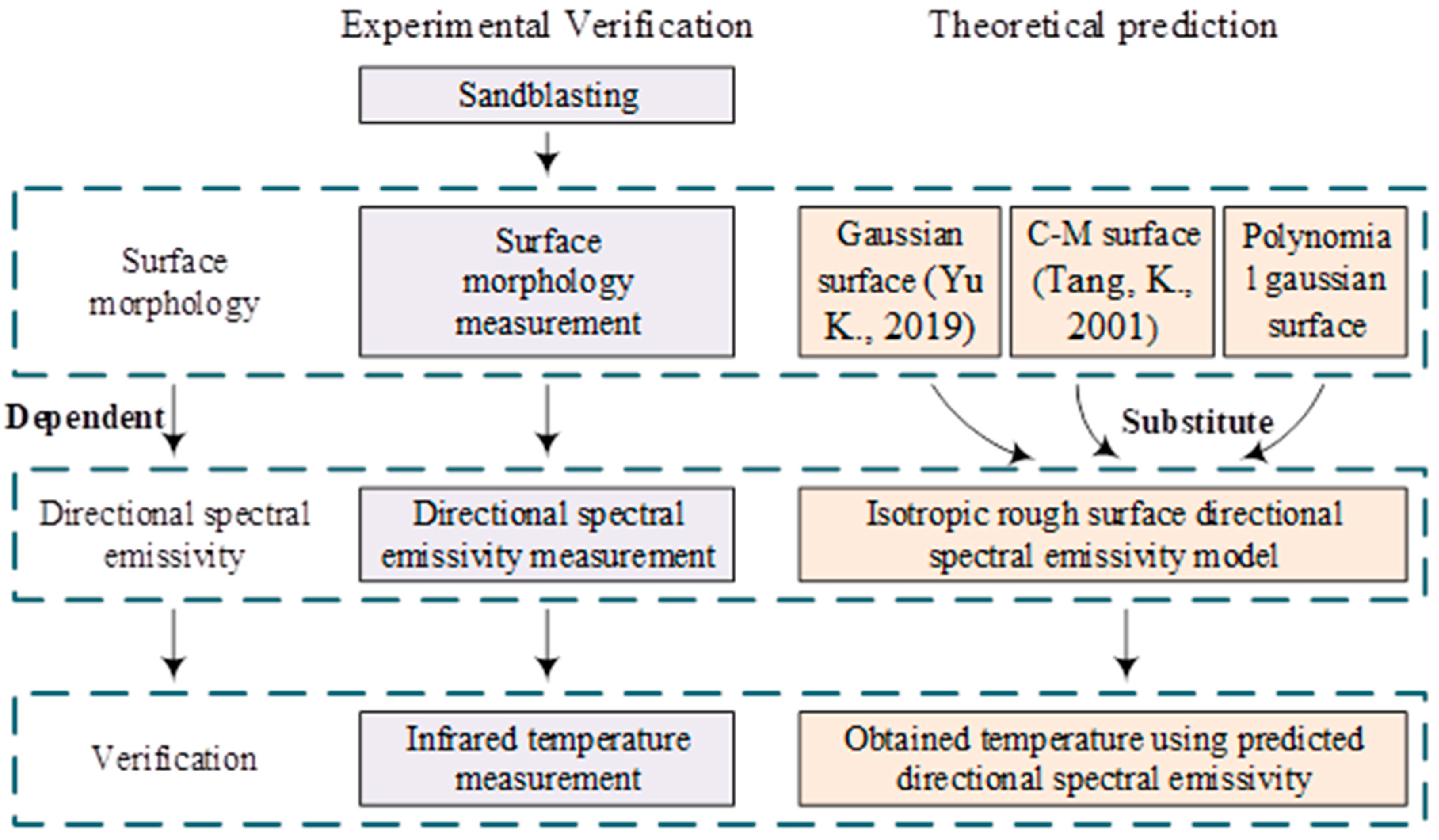Prediction of Isotropic Rough Surface Directional Spectral Emissivity with Surface-Morphology-Dependent Modelling
Abstract
:1. Introduction
2. Modelling of Isotropic Rough Surface Directional Spectral Emissivity
- (1)
- The refractive index on the surface and inside the material is irrelevant to spatial direction;
- (2)
- The surface height and slope are distributed randomly;
- (3)
- The surface height and slope distribution obey the same probability density function in any direction on the plane.
2.1. Derivation of Viewing Possibility Density Function
2.2. Derivation of Shadowing Function
2.3. Derivation of Directional Spectral Emissivity
3. Experimental Verification
3.1. Preparation of Sandblasted Surface
3.2. Surface Morphology Measurement of Sandblasted Samples
3.3. Directional Spectral Emissivity Measurement of Sandblasted Surface
3.3.1. Method of Directional Spectral Emissivity Measurement
3.3.2. Development of the Directional Spectral Emissivity Measurement Device
3.3.3. Procedure of Directional Spectral Emissivity Measurement
3.4. Infrared Temperature Measurement of Sandblasted Surface
4. Results and Discussion
4.1. Roughness of Sandblasted Surface
4.2. Surface Morphology Description of Sandblasted Surface
4.3. Comparation of Predicted with Measured Directional Spectral Emissivity
4.4. Accuracy Analysis of Infrared Temperature Measurement
5. Conclusions
- (1)
- The predicted directional spectral emissivity and measured temperature with the surface-morphology-dependent isotropic rough surface directional spectral emissivity model reached a relatively high accuracy, if the surface morphology is properly modelled;
- (2)
- The sandblasted surface is rough in both the sense of height and slope, and the surface kurtosis is large. The surface morphology of the samples shows good consistency and meets the assumed characteristics of isotropic rough surface;
- (3)
- The Gaussian surface and C-M surface are unable to depict the sandblasted surface morphology accurately, as more assumptions are employed in these models. The Polynomial surface expresses the surface morphology with relatively high accuracy by introducing the distribution of height and slope;
- (4)
- The directional spectral emissivity of the sandblasted surface decreases with increasing viewing angle, and its slope increases with increasing viewing angle. The Gaussian surface and the C-M surface underestimate the roughness of the surface, introducing more errors in the predicted directional spectral emissivity and measured temperature. The Polynomial surface depicts the surface with better accuracy, leading to a higher accuracy.
Author Contributions
Funding
Data Availability Statement
Conflicts of Interest
References
- Avanzini, A.; Battini, D.; Gelfi, M.; Girelli, L.; Petrogalli, C.; Pola, A.; Tocci, M. Investigation on fatigue strength of sand-blasted DMLS-AlSi10Mg alloy. Procedia Struct. Integr. 2019, 18, 119–128. [Google Scholar] [CrossRef]
- Ahmadi, S.M.; Kumar, R.; Borisov, E.V.; Petrov, R.; Leeflang, S.; Li, Y.; Tümer, N.; Huizenga, R.; Ayas, C.; Zadpoor, A.A.; et al. From microstructural design to surface engineering: A tailored approach for improving fatigue life of additively manufactured meta-biomaterials. Acta Biomater. 2019, 83, 153–166. [Google Scholar] [CrossRef]
- Feng, Z.Q.; Wang, L.; Wang, W.Z.; Di Cheng, K.; Chen, C.Z. Failure Analysis of the outside Coating on the Furnace Roller. Appl. Mech. Mater. 2016, 853, 431–435. [Google Scholar]
- Guimarães, B.; Rosas, J.; Fernandes, C.M.; Figueiredo, D.; Lopes, H.; Paiva, O.C.; Silva, F.S.; Miranda, G. Real-Time Cutting Temperature Measurement in Turning of AISI 1045 Steel through an Embedded Thermocouple—A Comparative Study with Infrared Thermography. J. Manuf. Mater. Process. 2023, 7, 50. [Google Scholar] [CrossRef]
- Heigel, J.; Whitenton, E.; Lane, B.; Donmez, M.; Madhavan, V.; Moscoso-Kingsley, W. Infrared measurement of the temperature at the tool–chip interface while machining Ti–6Al–4V. J. Mater. Process. Technol. 2017, 243, 123–130. [Google Scholar] [CrossRef]
- Meola, C.; Boccardi, S.; Carlomagno, G.; Boffa, N.; Ricci, F.; Simeoli, G.; Russo, P. Impact damaging of composites through online monitoring and non-destructive evaluation with infrared thermography. NDT E Int. 2017, 85, 34–42. [Google Scholar] [CrossRef]
- DeShong, E.; Peters, B.; Paynabar, K.; Gebraeel, N.; Thole, K.A.; Berdanier, R.A. Applying Infrared Thermography as a Method for Online Monitoring of Turbine Blade Coolant Flow. J. Turbomach. 2022, 144, 1–10. [Google Scholar] [CrossRef]
- Xu, D.; Ding, L.; Liu, Y.; Zhou, J.; Liao, Z. Investigation of the Influence of Tool Rake Angles on Machining of Inconel 718. J. Manuf. Mater. Process 2021, 5, 100. [Google Scholar] [CrossRef]
- Liu, D.; Liu, Z.; Zhao, J.; Song, Q.; Ren, X.; Ma, H. Tool wear monitoring through online measured cutting force and cutting temperature during face milling Inconel 718. Int. J. Adv. Manuf. Technol. 2022, 122, 729–740. [Google Scholar] [CrossRef]
- Peroni, L.; Scapin, M. Plastic Behavior of Laser-Deposited Inconel 718 Superalloy at High Strain Rate and Temperature. Appl. Sci. 2021, 11, 7765. [Google Scholar] [CrossRef]
- Liu, Z.; Li, T.; Ning, F.; Cong, W.; Kim, H.; Jiang, Q.; Zhang, H. Effects of deposition variables on molten pool temperature during laser engineered net shaping of Inconel 718 superalloy. Int. J. Adv. Manuf. Technol. 2019, 102, 969–976. [Google Scholar] [CrossRef]
- Xu, L.; Chai, Z.; Chen, H.; Zhang, X.; Xie, J.; Chen, X. Tailoring Laves phase and mechanical properties of directed energy deposited Inconel 718 thin-wall via a gradient laser power method. Mater. Sci. Eng. A 2021, 824, 141822. [Google Scholar] [CrossRef]
- El Bakali, A.; Gilblas, R.; Pottier, T.; Lieurey, A.; Le Maoult, Y. Effect of oxidation on spectral and integrated emissivity of Ti-6Al-4V alloy at high temperatures. J. Alloy. Compd. 2021, 889, 161545. [Google Scholar] [CrossRef]
- Qi, J.; Eri, Q.; Kong, B.; Zhang, Y. The radiative characteristics of inconel 718 superalloy after thermal oxidation. J. Alloy. Compd. 2020, 854, 156414. [Google Scholar] [CrossRef]
- Yu, K.; Zhang, H.; Liu, Y.; Liu, Y. Study of normal spectral emissivity of copper during thermal oxidation at different temperatures and heating times. Int. J. Heat Mass Transf. 2019, 129, 1066–1074. [Google Scholar] [CrossRef]
- Keller, B.P.; Nelson, S.E.; Walton, K.; Ghosh, T.K.; Tompson, R.V.; Loyalka, S.K. Total hemispherical emissivity of Inconel 718. Nucl. Eng. Des. 2015, 287, 11–18. [Google Scholar] [CrossRef]
- Balat-Pichelin, M.; Sans, J.; Bêche, E.; Flaud, V.; Annaloro, J. Oxidation and emissivity of Inconel 718 alloy as potential space debris during its atmospheric entry. Mater. Charact. 2017, 127, 379–390. [Google Scholar] [CrossRef]
- Tang, K.; Buckius, R.O. A statistical model of wave scattering from random rough surfaces. Int. J. Heat Mass Transf. 2001, 44, 4059–4073. [Google Scholar] [CrossRef]
- Rozanski, L.; Majchrowski, R.; Staniek, R. Choosing of roughness parameters to describe the diffuse reflective and emissive properties of selected dielectrics. Quant. Infrared Thermogr. J. 2014. [Google Scholar] [CrossRef]
- Smith, B.G. Geometrical Shadowing of a Random Rough Surface. IEEE Trans. Antennas Propag. 1967, 15, 668–671. [Google Scholar] [CrossRef]
- Bourlier, C. Unpolarized infrared emissivity with shadow from anisotropic rough sea surfaces with non-Gaussian statistics. Appl. Opt. 2005, 44, 4335–4349. [Google Scholar] [CrossRef] [PubMed]
- Chen, M.; Pang, Q.; Wang, J.; Cheng, K. Analysis of 3D microtopography in machined KDP crystal surfaces based on fractal and wavelet methods. Int. J. Mach. Tools Manuf. 2008, 48, 905–913. [Google Scholar] [CrossRef]
- Bourlier, C.; Berginc, G. Shadowing function with single reflection from anisotropic Gaussian rough surface. Application to Gaussian, Lorentzian and sea correlations. Waves Random Media 2003, 13, 27–58. [Google Scholar] [CrossRef]
- King, J.L.; Jo, H.; Loyalka, S.K.; Tompson, R.V.; Sridharan, K. Computation of total hemispherical emissivity from directional spectral models. Int. J. Heat Mass Transf. 2017, 109, 894–906. [Google Scholar] [CrossRef]
- Jo, H.; King, J.L.; Blomstrand, K.; Sridharan, K. Spectral emissivity of oxidized and roughened metal surfaces. Int. J. Heat Mass Transf. 2017, 115, 1065–1071. [Google Scholar] [CrossRef]
- Li, H.; Pinel, N.; Bourlier, C. A monostatic illumination function with surface reflections from one-dimensional rough surfaces. Waves Random Complex Media 2011, 21, 105–134. [Google Scholar] [CrossRef]
- Li, H.; Pinel, N.; Bourlier, C. Polarized infrared reflectivity of one-dimensional Gaussian sea surfaces with surface reflections. Appl. Opt. 2013, 52, 6100–6111. [Google Scholar] [CrossRef]
- Li, H.; Pinel, N.; Bourlier, C. Polarized infrared reflectivity of 2D sea surfaces with two surface reflections. Remote Sens. Environ. 2014, 147, 145–155. [Google Scholar] [CrossRef]
- Li, H.; Pinel, N.; Bourlier, C. Polarized infrared emissivity of 2D sea surfaces with one surface reflection. Remote Sens. Environ. 2012, 124, 299–309. [Google Scholar] [CrossRef]
- Wen, C.-D.; Mudawar, I. Modeling the effects of surface roughness on the emissivity of aluminum alloys. Int. J. Heat Mass Transf. 2006, 49, 4279–4289. [Google Scholar] [CrossRef]
- Rubanenko, L.; Schorghofer, N.; Greenhagen, B.T.; Paige, D.A. Equilibrium Temperatures and Directional Emissivity of Sunlit Airless Surfaces With Applications to the Moon. J. Geophys. Res. Planets 2020, 125, e2020JE006377. [Google Scholar] [CrossRef]
- Warren, T.J.; Bowles, N.E.; Hanna, K.D.; Bandfield, J.L. Modeling the Angular Dependence of Emissivity of Randomly Rough Surfaces. J. Geophys. Res. Planets 2019, 124, 585–601. [Google Scholar] [CrossRef]
- Cox, C.; Munk, W. Some problems in optical oceanography. J. Mar. Res. 1995, 14, 63–78. [Google Scholar]
- Hu, J.; Liu, Z.; Zhao, J.; Wang, B.; Song, Q. Theoretical Modeling and Analysis of Directional Spectrum Emissivity and Its Pattern for Random Rough Surfaces with a Matrix Method. Symmetry 2021, 13, 1733. [Google Scholar] [CrossRef]
- Bourlier, C.; Berginc, G.; Saillard, J. Monostatic and bistatic statistical shadowing functions from a one-dimensional stationary randomly rough surface according to the observation length: I. Single scattering. Waves Random Media 2002, 12, 145–173. [Google Scholar] [CrossRef]
- Yoshimori, K.; Itoh, K.; Ichioka, Y. Optical characteristics of a wind-roughened water surface: A two-dimensional theory. Appl. Opt. 1995, 34, 6236–6247. [Google Scholar] [CrossRef]
- Smith, B.G. Lunar surface roughness: Shadowing and thermal emission. J. Geophys. Res. 1967, 72, 4059–4067. [Google Scholar] [CrossRef]
- Zhao, J.; Liu, Z.; Wang, B.; Hua, Y.; Wang, Q. Cutting temperature measurement using an improved two-color infrared thermometer in turning Inconel 718 with whisker-reinforced ceramic tools. Ceram. Int. 2018, 44, 19002–19007. [Google Scholar] [CrossRef]
- Hu, Y.Z.; Tonder, K. Simulation of 3-D random rough surface by 2-D digital filter and fourier analysis. Int. J. Mach. Tools Manuf. 1992, 32, 83–90. [Google Scholar] [CrossRef]
- Kong, B.; Li, T.; Eri, Q. Normal spectral emissivity measurement on five aeronautical alloys. J. Alloys Compd. 2017, 703, 125–138. [Google Scholar] [CrossRef]
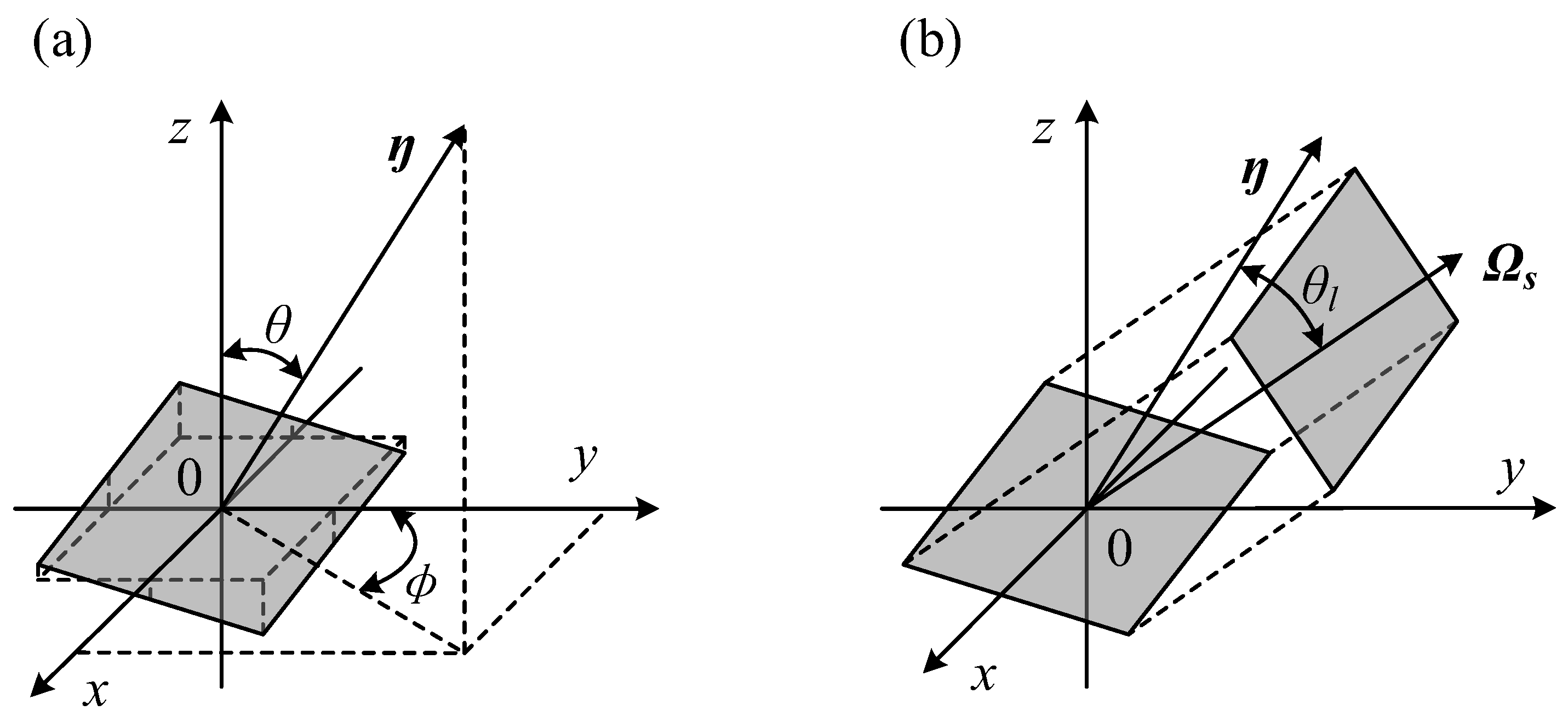
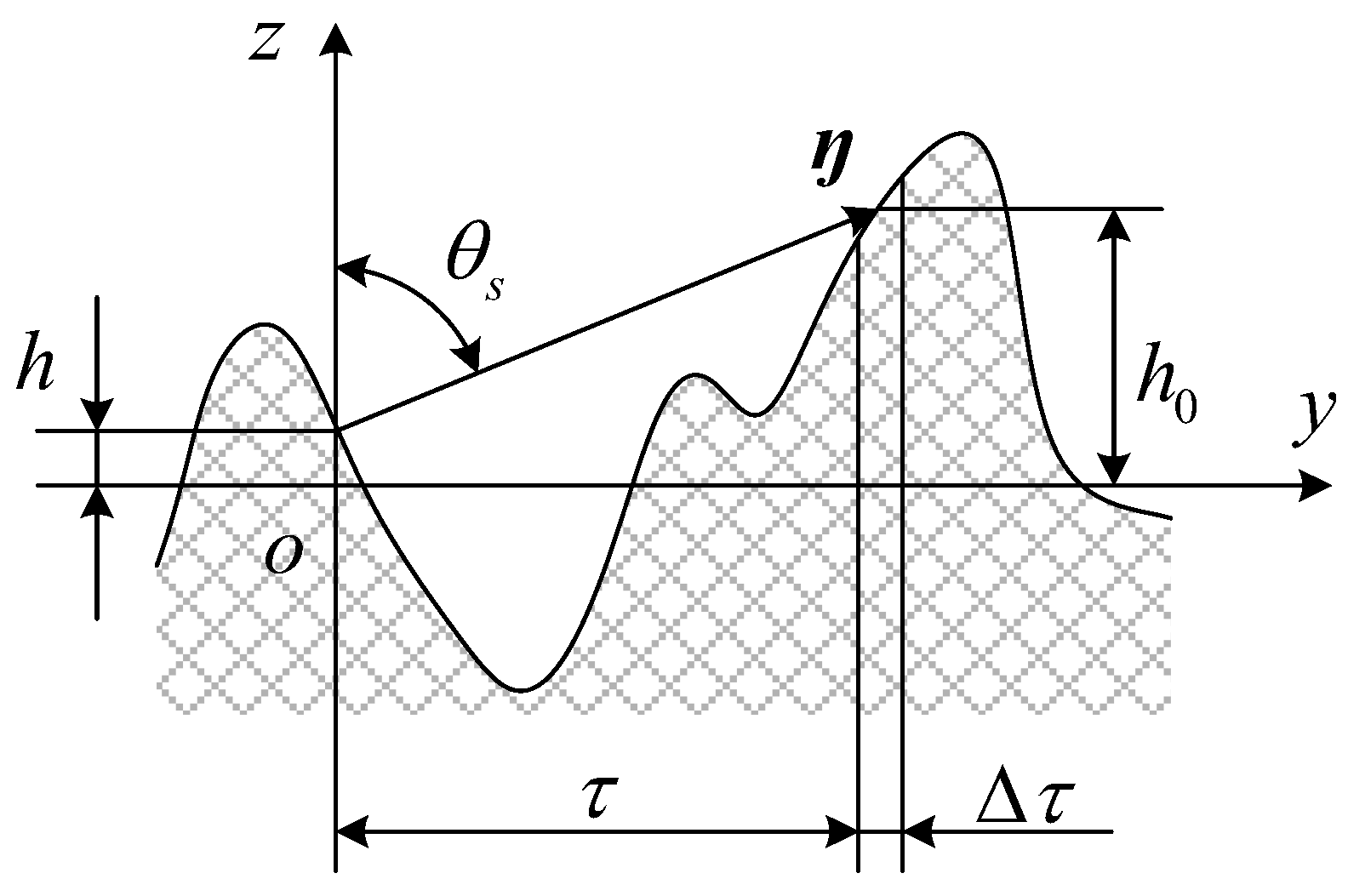
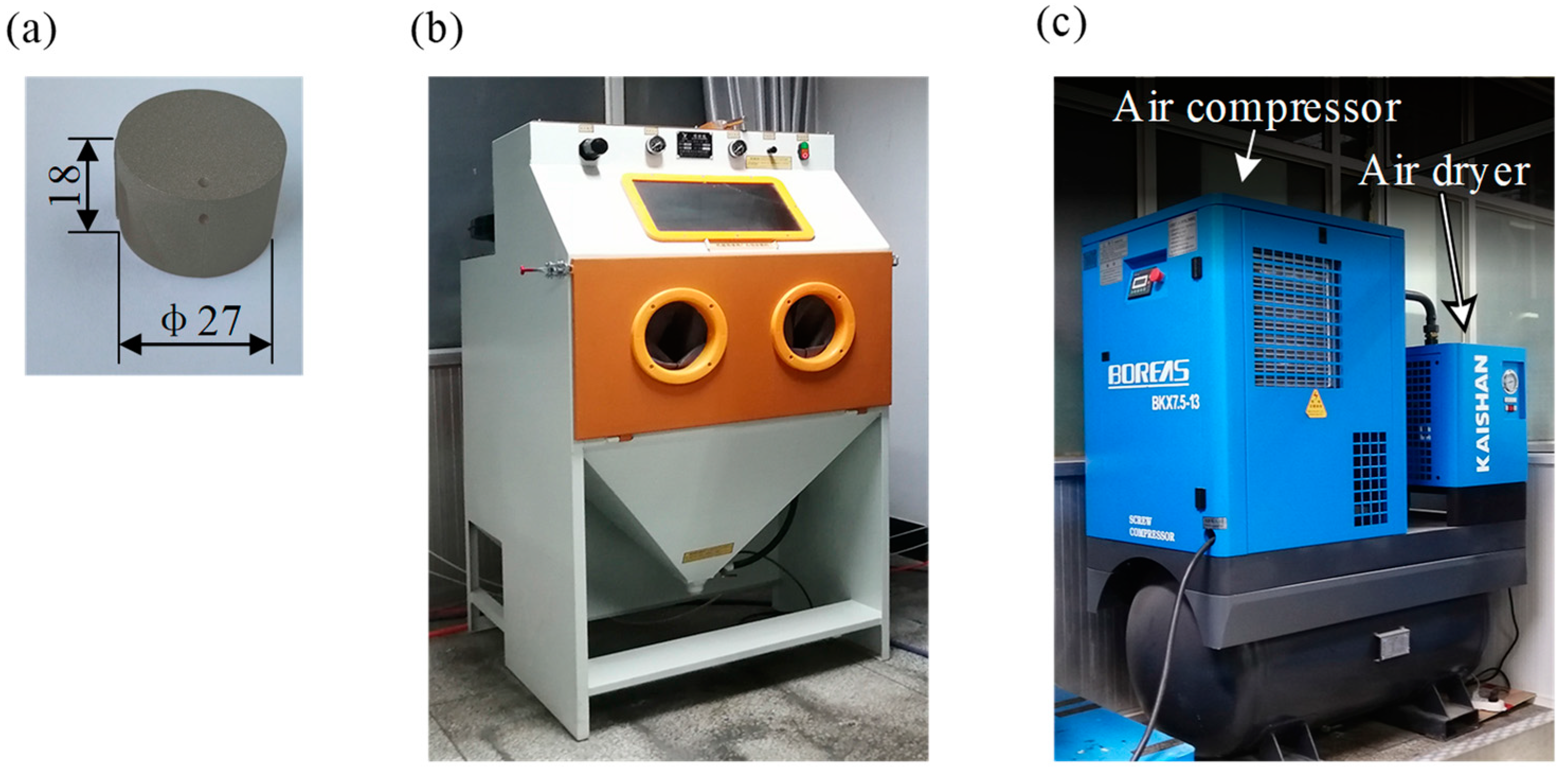
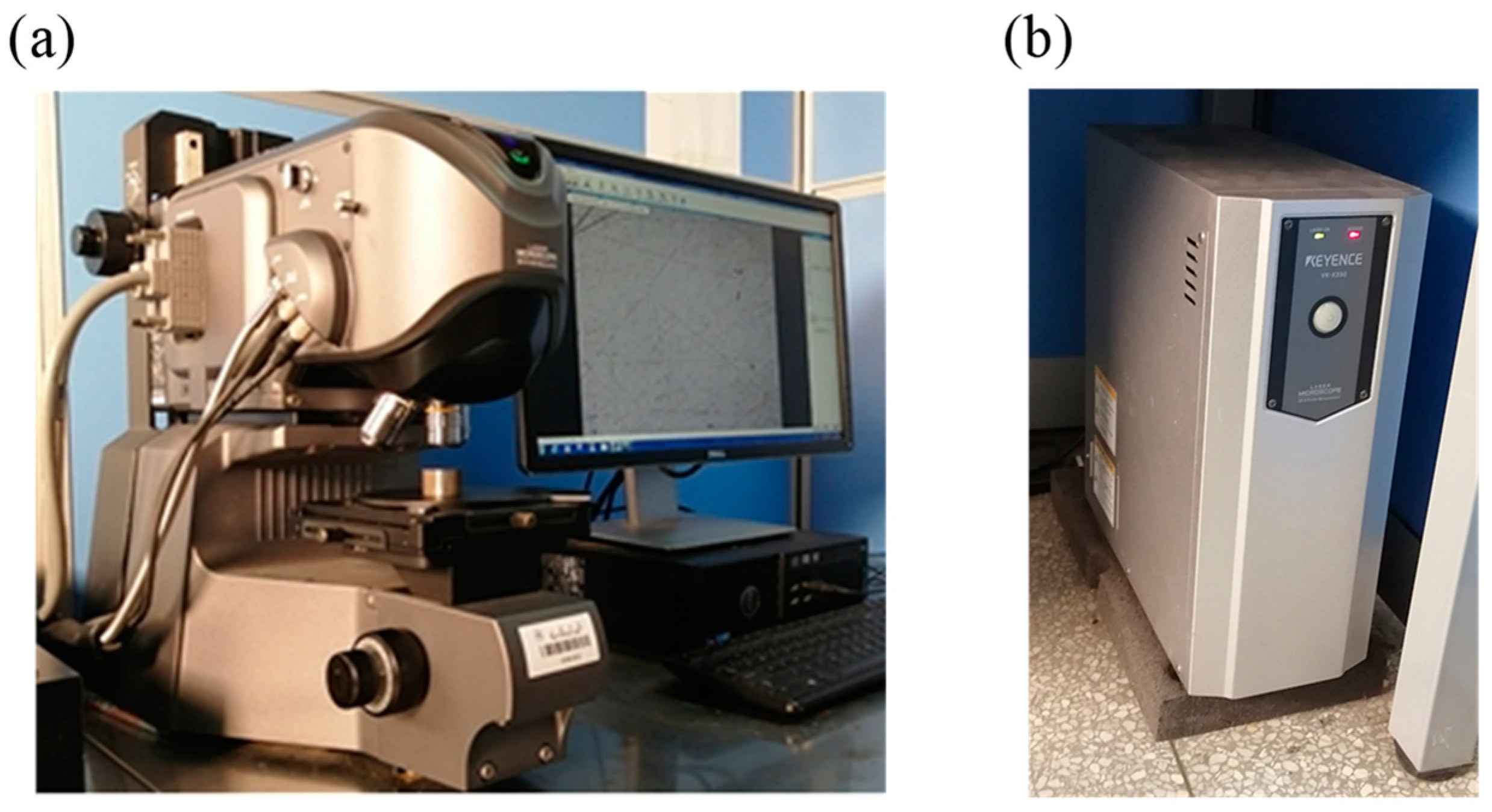
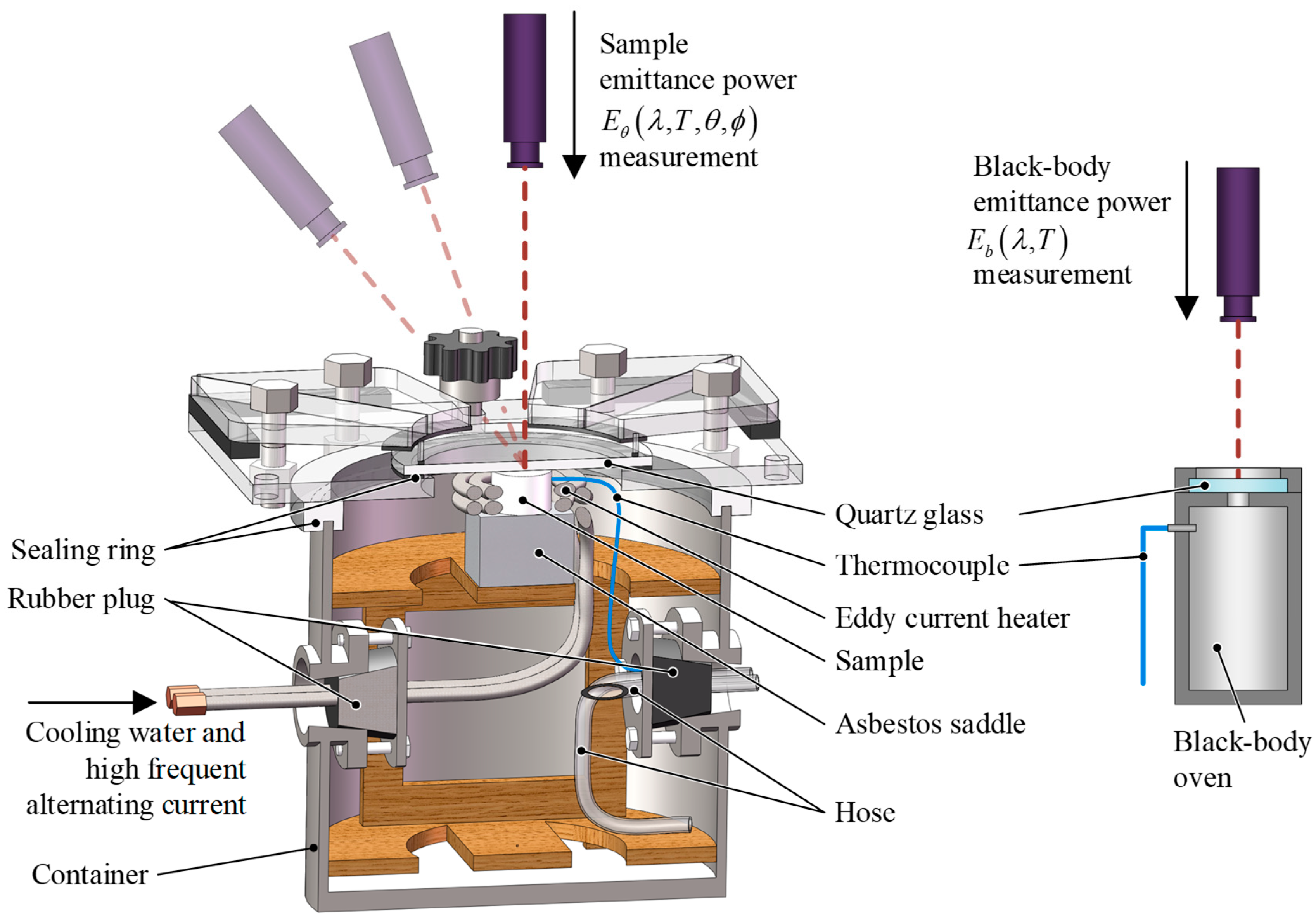
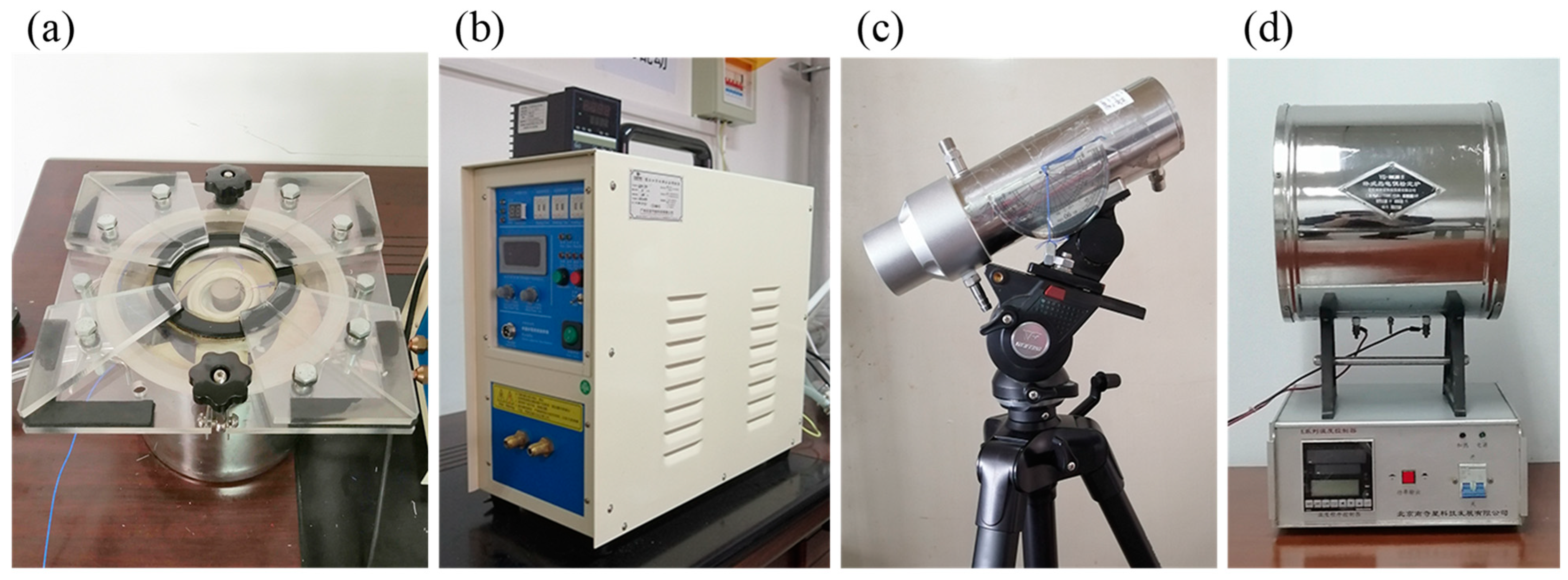
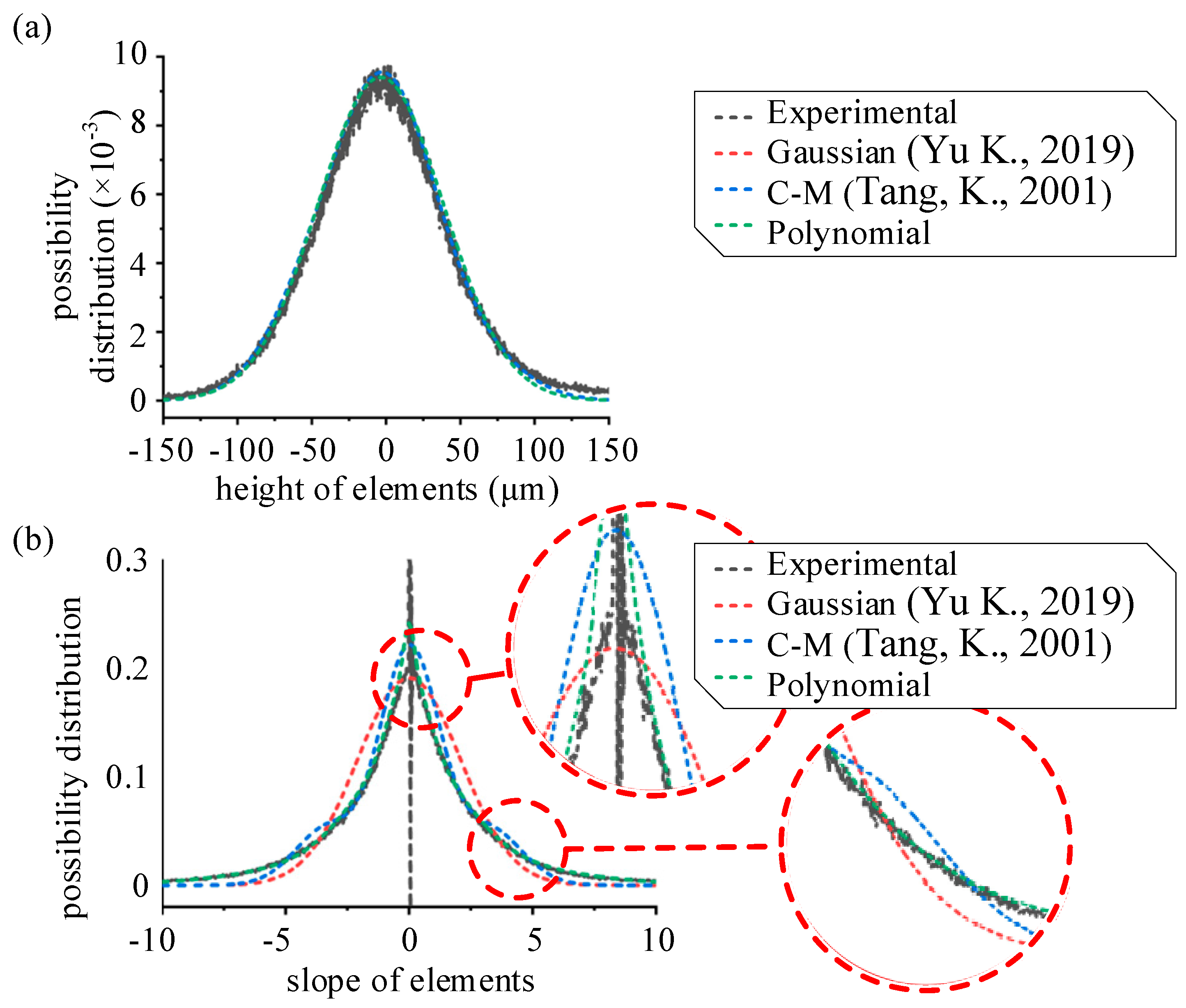
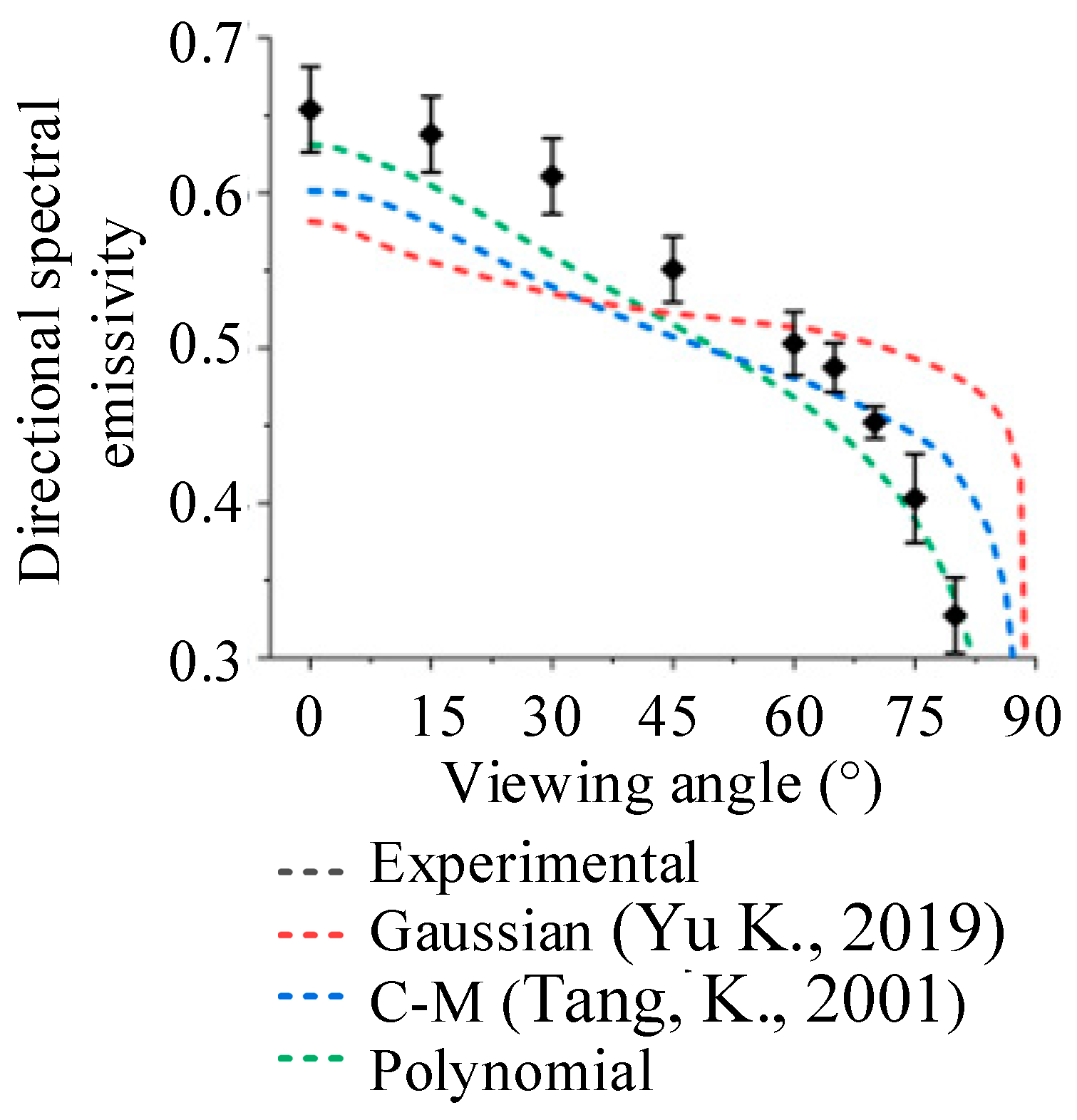
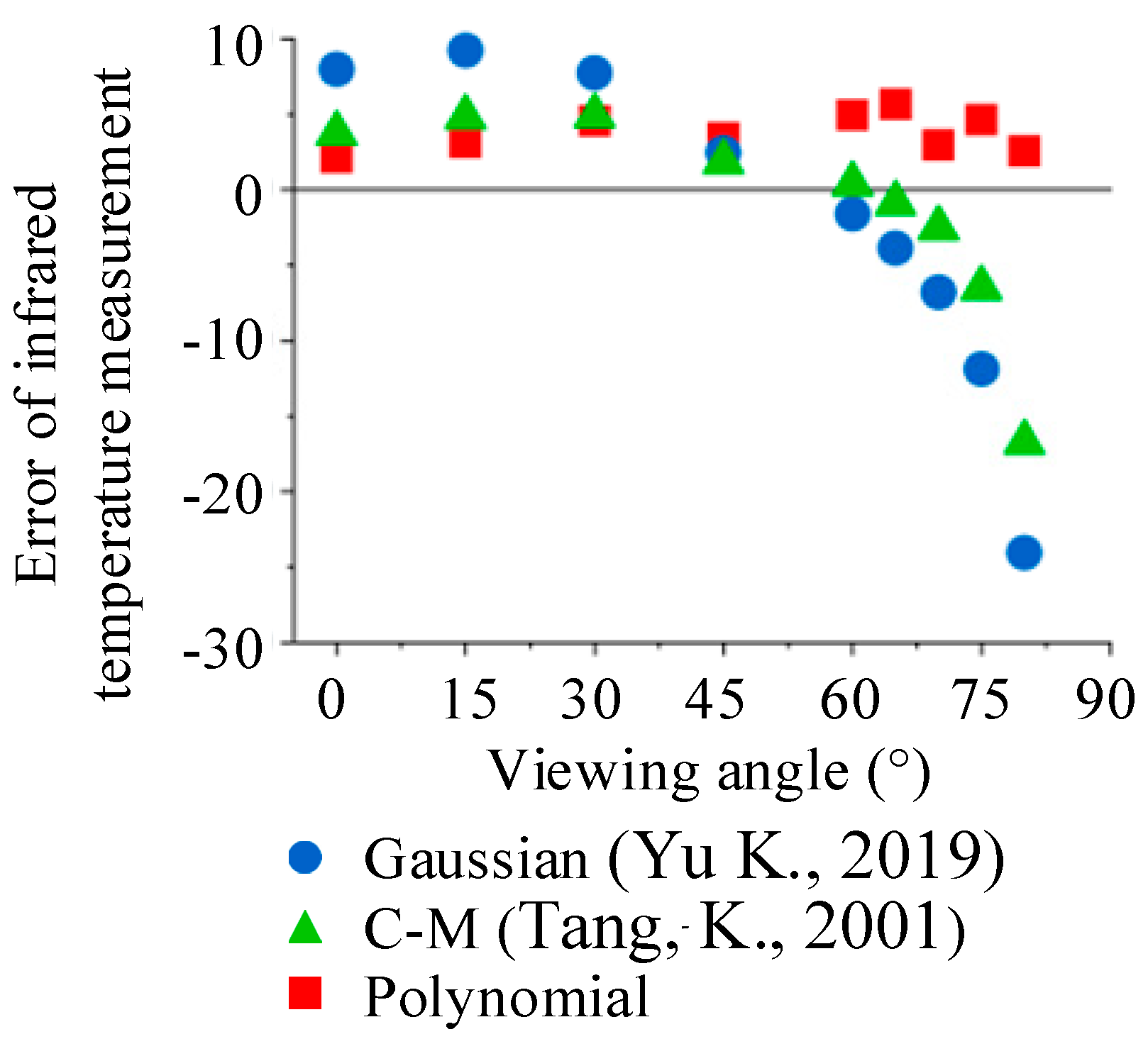
| Parameter | Sa (μm) | Sq (μm) | Sdq | Ssk | Sku |
|---|---|---|---|---|---|
| mean | 3.769 | 5.265 | 5.284 | 0.666 | 6.778 |
| standard deviation | 0.052 | 0.083 | 0.207 | 0.096 | 0.180 |
Disclaimer/Publisher’s Note: The statements, opinions and data contained in all publications are solely those of the individual author(s) and contributor(s) and not of MDPI and/or the editor(s). MDPI and/or the editor(s) disclaim responsibility for any injury to people or property resulting from any ideas, methods, instructions or products referred to in the content. |
© 2023 by the authors. Licensee MDPI, Basel, Switzerland. This article is an open access article distributed under the terms and conditions of the Creative Commons Attribution (CC BY) license (https://creativecommons.org/licenses/by/4.0/).
Share and Cite
Hu, J.; Liu, Z.; Zhao, J.; Wang, B. Prediction of Isotropic Rough Surface Directional Spectral Emissivity with Surface-Morphology-Dependent Modelling. Metals 2023, 13, 1679. https://doi.org/10.3390/met13101679
Hu J, Liu Z, Zhao J, Wang B. Prediction of Isotropic Rough Surface Directional Spectral Emissivity with Surface-Morphology-Dependent Modelling. Metals. 2023; 13(10):1679. https://doi.org/10.3390/met13101679
Chicago/Turabian StyleHu, Jianrui, Zhanqiang Liu, Jinfu Zhao, and Bing Wang. 2023. "Prediction of Isotropic Rough Surface Directional Spectral Emissivity with Surface-Morphology-Dependent Modelling" Metals 13, no. 10: 1679. https://doi.org/10.3390/met13101679
APA StyleHu, J., Liu, Z., Zhao, J., & Wang, B. (2023). Prediction of Isotropic Rough Surface Directional Spectral Emissivity with Surface-Morphology-Dependent Modelling. Metals, 13(10), 1679. https://doi.org/10.3390/met13101679








